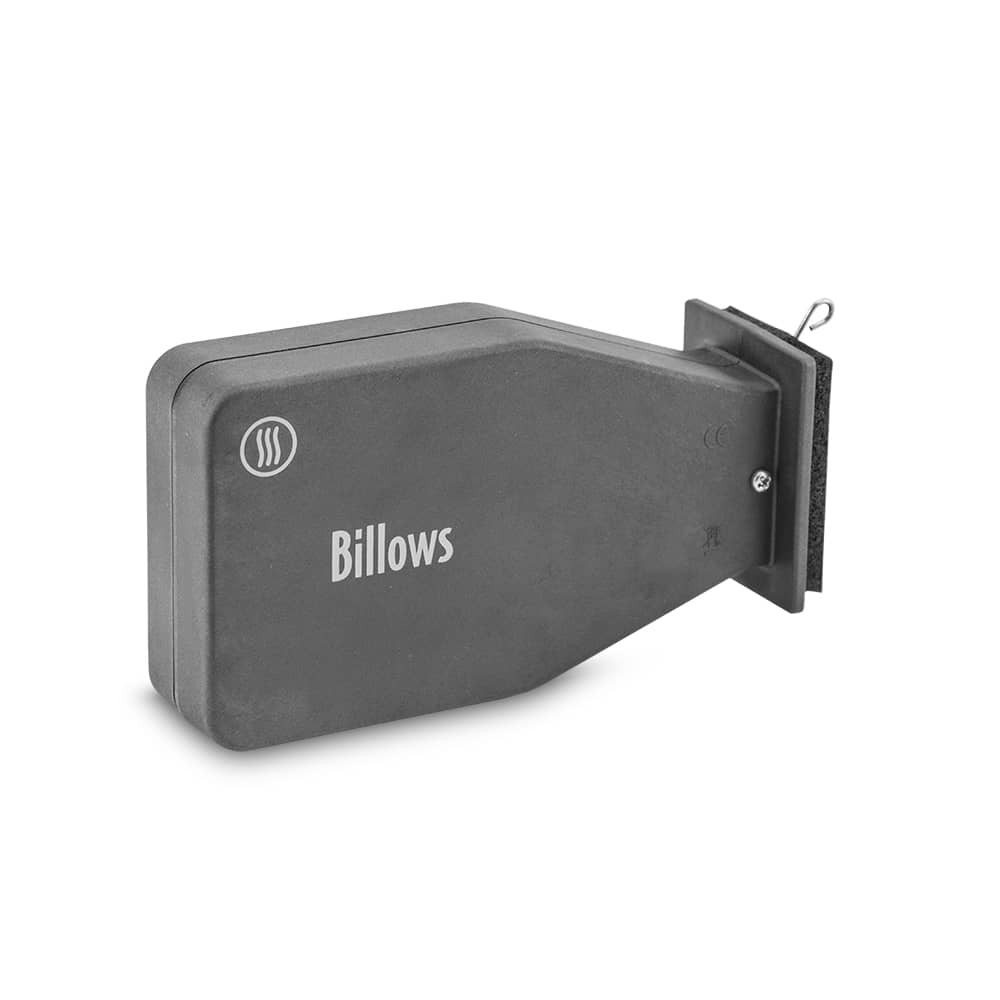Take the Corned Beef out of the package and put it in a big pot with water to cover the meat.
Bring water to boil. Cut open the spice packet and add the desired amount of the enclosed spice packet to water for a stronger flavor.
Reduce to simmer and cover. Simmer for approx. 2 1/2 – 3 hours or until firmly fork tender. For food safety, an internal temperature of at least 160°F must be reached; for maximum tenderness, an internal temperature of 190°F must be reached.
After removing the meat from the pot, let it rest for 5 to 10 minutes. Slice thinly across the grain and serve.
Cook in a 275°F oven for three to four hours, or until thoroughly fork tender. For food safety, an internal temperature of at least 160°F must be reached; for maximum tenderness, an internal temperature of 190°F must be reached.
Take the meat out of the oven and let it rest for five to ten minutes. Slice thinly across the grain and serve.
History of Corned Beef and Cabbage:
Corned beef is Irish…kind of. It’s a famous dish that early Irish immigrants created out of necessity. A typical Irish family meal prior to immigration to the United States would have included cured pork and potatoes. After traveling to the U. S. Irish immigrants who were struggling financially in the 1800s discovered that pork and potatoes were far too expensive.
Jewish immigrants who didn’t sell pork in their butcher shops and knew how to cure cheap cuts of beef lived and worked in the same neighborhoods as the Irish immigrants. Instead of using potatoes, the Irish boiled the cured beef brisket with cabbage to make hearty meals. Although corned beef and cabbage may not have come from Ireland, it is a true Irish-American dish. A great dish to celebrate Irish-immigrant heritage!.
People often ask about the corn in corned beef. And the truth is, there is none. The coarse-grained salt that was initially used to cure the meat is what gives corned beef its “corn” flavor. The beef was given the name “corned” by these salty kernels; the word “corn” here refers to anything the size of a grain rather than a particular type of grain. So that’s why there’s no corn in the dish!.
The process of salting meat to cure it is known as “corning.” And although salt-curing meat has been used to preserve meat for centuries (the chemical composition prevents bacterial growth), we now primarily cure meat for the flavor and texture benefits associated with the procedure.
To properly cure a brisket for corned beef, Prague powder #1 (pink curing salt) is an essential ingredient. The meat’s myoglobin reacts with the sodium nitrite to produce nitric oxide, giving the brisket its pink color. This reaction is also responsible for the slightly tart flavor of cured meat.
Curing salt is pink to distinguish it from table salt. The meat turns pink during the curing process, not from additional pink coloring.
A note on brisket
Beef brisket is one tough piece of meat. Due to the pectoral muscle bearing a large portion of the animal’s weight, this cut is heavily worked. Weight-bearing muscles’ extremely resilient protein fibers are bound together by a web of connective tissue made primarily of collagen.
Due to the cut’s tough texture and connective tissue, it must be cooked slowly and held at a higher temperature for a longer period of time in order to fully break down the collagen and turn it into gelatin. Gelatin can take up between six and ten times its weight in water once it has formed. To achieve the desired moist and silky texture so frequently associated with tough cuts like brisket and pork shoulder, gelatin is crucial.
Why time and temperature matter for cooking corned beef:
Although the internal temperature of the meat only needs to reach 145°F (63°C) for food safety, collagen doesn’t start to dissolve until 160–180°F (71–82°C). Low and slow heat must be applied to the protein to keep it tender, but the tender protein will be ineffective unless the connective tissue has been rendered down to work its silky magic. We advise cooking brisket to an internal temperature of 190-205°F (88-96°C) for the best collagen breakdown and gelatin development.
Homemade Corned Beef Cure Recipe
We used a Corned Beef Brisket recipe from Kenji Lopez-Alt of Serious Eats.
A word about curing salt: It should be added based on the weight of the meat. For every 5 lb meat, use 1 tsp curing salt. Make the necessary conversion for the amount of salt after weighing your brisket. Don’t just assume that because some curing salt preserves something, more will be better because too much of it can be toxic.
- 1 brisket flat
- 3/4 cup kosher salt
- 1 teaspoon pink curing salt (Prague powder #1, NOT Himalayan pink salt, which is entirely different).
- 2 tablespoons brown sugar
- 2 tablespoons whole black peppercorns
- 1 tablespoon yellow mustard seeds
- 2 tablespoons whole coriander seeds
- 1 tablespoon allspice berries
- 6 whole cloves
- 1 tablespoon ground ginger
- 6 bay leaves, roughly torn
- Pat the brisket dry with paper towels.
- In a bowl, combine the pink (curing) salt, sugar, and salt.
- Place the brisket in a rimmed baking sheet.
- Rub the brisket all over with the salt/sugar mixture. Place any leftover salt mixture on top of or underneath the brisket in the pan.
- Combine the spices in a bowl.
- Rub the spices all over the surfaces.
- Cover the brisket and pan tightly with plastic wrap.
- Place in the refrigerator.
- Over the next 7 to 10 days, flip it, unwrap it, and then rewrap it a few times.
Now you just need to wait 7-10 days…
Traditional method for cooking corned beef: boil it hard
It’s time to cook the corned beef now that it has been cured. But how? Traditionally, corned beef is made by placing it in a pot and boiling it for the entire day while adding potatoes, cabbage, and carrots for the last 40 minutes or so. Thus it has been for generations. Of course, earlier people were notorious for overcooking their vegetables, and they also lacked the advantage of accurate thermometry!
Why boiling hard all day works
Brisket is a tough meat that is rich in connective tissue, as we mentioned above. If the collagen isn’t broken down into gelatin, it will result in chewy corned beef. The lengthy hard boil will raise the meat’s temperature to the collagen-melting range, which is above 160°F (71°C), where the collagen will melt and become soft and delectable gelatin.
The dreaded “stall” is something that everyone who has ever smoked a brisket is familiar with. When the collagen in the brisket begins to break down and release water, this phenomenon happens. It acts as perspiration and cools the brisket as the water evaporates in the hot smoker, sometimes for hours, and it won’t stop until enough water has left the meat for the temperature to rise once more. Bother.
By boiling the corned beef, the stall is completely avoided. Water covering the beef prevents evaporation and, consequently, cooling The only direct path for heat to leave the water is through the surface, and a flame underneath the pot keeps enough heat coming in to prevent your cook from being hindered by the relatively little amount of heat venting out the top.
Cooking can be as simple as placing a slab of beef in a large pot and pressing “go.” If there were other things to do besides cooking, busy immigrant families probably thought of this as the ideal method (aside from the cost of fuel for an all-day stove flame).
Why an all-day hard boil doesn’t work
We are all aware that a steak can be overcooked and become dry; if you allow it to reach 150°F (66°C), you might as well give it to the kids who don’t know any better. Brisket, which can tolerate a much higher temperature, can also become overcooked. You’ll have a crumbly, dried-out piece of salted beef if all the collagen turns to gelatin, but if all the gelatin cooks out of the corned beef, that’s not good.
Additionally, hard boiling meat all day will drain its flavor, leaving it a mere shell of what it once could have been.
What would the ideal method be?
In researching how to achieve corned beef perfection, we looked closely at what J. Kenji López-Alt had to say on the subject. After multiple cooks for multiple times and multiple temperatures, Kenji reported the best method for his taste preference was to cook the corned beef for ~10 hours at 180°F (82°C). This resulted in a texture that he liked best with a happy medium between structural breakdown and juiciness.
Mind you, that’s his preference. His research demonstrated that cooking corned beef at a higher temperature for a shorter period of time results in a flakier, albeit slightly drier, texture.
What’s going on here?
Collagen breakdown is a function of time and temperature. The meat will start to soften once you reach the temperature at which gelatin is created, which is about 160°F (71°C). But at that temperature, it will take 36 hours to become tender, whereas at 205°F (96°C), it takes only 3 hours. However, because the internal temperature will have increased overall, other protein reactions will have taken place, making the meat flakier and drier.
How to cook corned beef perfectly
Here, the line between tradition and modern science is particularly thin. The traditional method is a hard boil all day. Depending on your preference for a certain level of texture, you can simmer this for as little as 3 hours or as long as all day.
Controlling the temperature is essential to achieving that level of textural accuracy. You could sous vide it, so how do you get that control? Sous vide is all about meticulous temperature control, but I think that if you sous vide this recipe for corned beef, it will be a little too salty. Some of the salt is drawn out when simmering it in open water, but vac-sealing it for sous vide will prevent that salt from escaping.
You could use a slow cooker. Since every slow cooker is unique, they all attempt to maintain various temperatures. Go for it if yours maintains a temperature that you like for the cook. But since there isn’t a slow cooker in the ThermoWorks demo kitchen, we got out the thermometers and made our own apparatus!
We put our beef in the pot and covered it with water. Then onto the stove it went, and we started to monitor the temp once it started to visibly simmer. We tried to maintain a water temp of ~195°F (91°C) to balance texture and speed. Because we were taking a more scientific approach to this cook, we used a SmokeTM dual-channel thermometer and a Pro-Series Waterproof Needle Probe to monitor both the temperature of the water and the internal temperature of the corned beef. We wanted to know exactly what was going on with the beef temperature, etc. But if you don’t have a Smoke or ChefAlarm when you cook yours, sporadic monitoring of your water temperatures with an instant-read like the Thermapen® will also work.
What temperature is corned beef done?
If you want very firm but tender corned beef, keep your water at a high simmering temperature of 180°F (82°C), or 190-195°F (88-91°C) for flakier but quicker corned beef.
Using Smoke’s receiver is nice for this, as you don’t have to be by the pot to know what’s going on. But until the internal temp of the beef and the temp of the water start to equalize a bit, there’s going to be a lot of back-and-forth on your stove heat to maintain the temperature you want.
Your corned beef will still need to have time for the collagen to dissolve once it reaches the desired internal temperature. Our target temperature was 190°F (88°C), and it took the meat two hours to reach the desired consistency after reaching that temperature. Depending on your preferred temperature and texture, yours might take longer.
How to Cook Corned Beef—simmering
- Rinse the excess salt mixture from the corned beef.
- Place the beef in a pot. Cut it into smaller pieces if it’s too big and squish them together.
- Cover the beef with at least an inch of water.
- Use the Smokehouse probe and a pot clip for the water temperature and a waterproof needle probe for the meat if you’re using Smoke to track your cook.
- By adjusting the heat on your burner, warm your water to the desired temperature and keep it there.
- Use the Smoke or a Thermapen to check the internal temperature of your corned beef. Allow the meat to cook for at least two hours after reaching your target temperature, or until it can be easily pierced with a knife.
- As some water will be lost to steam as the food cooks, you might need to add more.
- Add any vegetables you want to boil with your beef once it is sufficiently tender, such as carrots, potatoes, turnips, cabbage, etc., to the pot. Allowing them to simmer with the beef until they reach your preferred consistency
- When the beef is cool enough to handle, remove it from the pot.
- Serve the beef, sliced to your preference, with the cooked vegetables and some quality mustard.
How to Smoke Corned Beef
Smoking is a non-traditional but delicious way to prepare corned beef. You still want to cook it in water at least part of the time to let some of the salt out of it, but smoking it before a steam/braise cycle will imbue it with a deep, smoky flavor. We followed the advice given at Taste of Home to get ours just right. This is a great way to jazz up a store-bought cured corned beef that won’t have as much depth of flavor as a home-cured version.
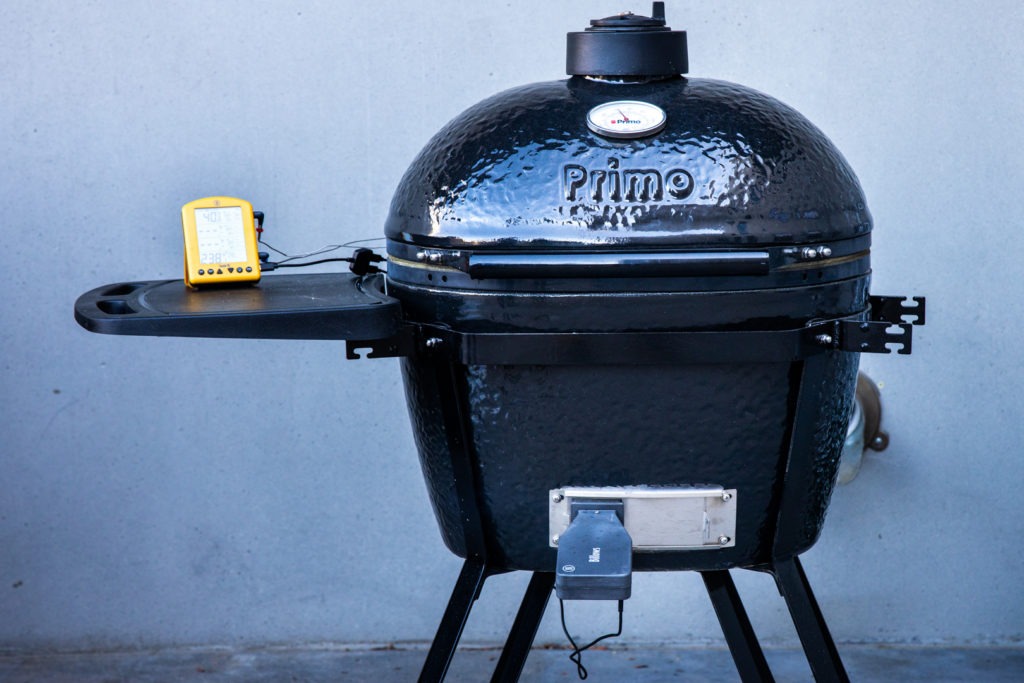
Using a leave-in probe thermometer like the Smoke X4™ to monitor the cook is a great way to make sure you hit your critical temperatures.
- 1 corned beef, raw, about 3 –5 pounds
- water
- Preheat your smoker to 275°F (135°C). Set your high-temperature alarm to 300°F (149°C), your low-temperature alarm to 250°F (121°C), and monitor your smoker with the receiver to make sure it stays within the recommended range if you’re using the BillowsTM BBQ control fan with your Smoke X4.
- Rinse your corned beef and pat it dry.
- Place the corned beef in the smoker after inserting the penetration probe there. Set the meat channel’s high-temperature alarm to 160°F (71°C).
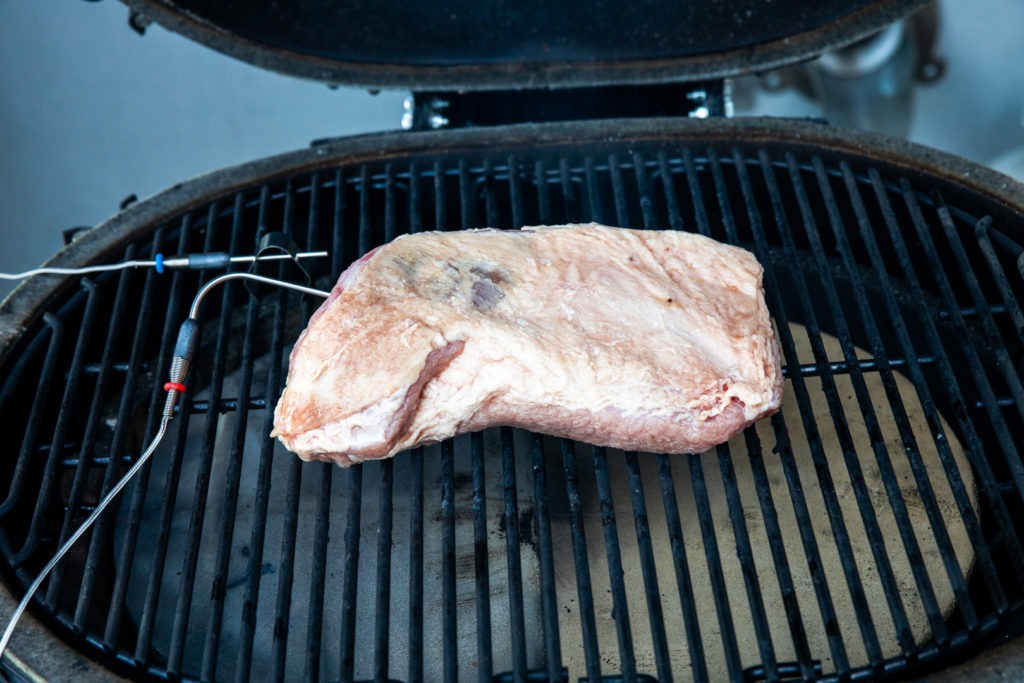
- Put your beef in a pan and fill it with water when the alarm goes off so that it comes about 1/3 of the way up the side of the meat.
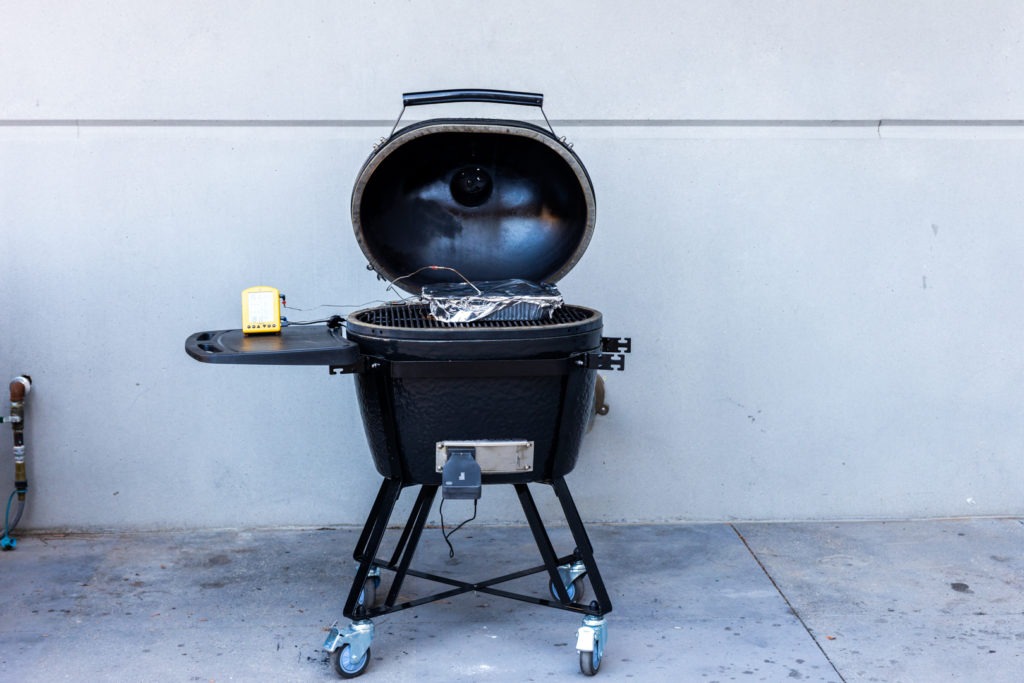
- Set your high-temp alarm for the meat to 203°F (95°C), tightly wrap the pan in foil, and insert the probe into the meat.
- Corned beef should be cooked in a pan until the alarm goes off. Make sure the meat has reached 203°F (95°C) throughout by using a Thermapen® to spot-check.

- The corned beef should be removed from the water pan, wrapped firmly in two layers of foil, then wrapped in a few towels and placed in a cooler to rest for at least an hour and ideally two.
- Slice thinly and serve!
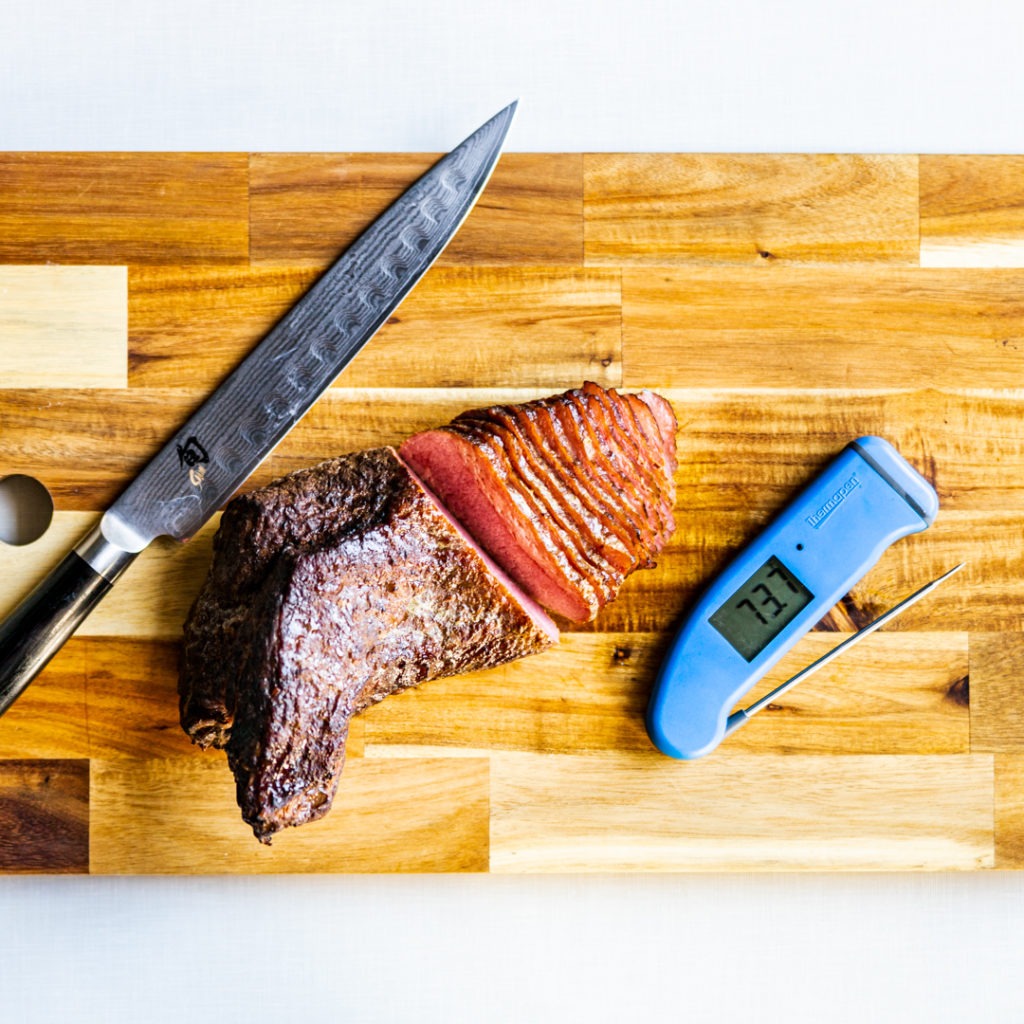
And there you have it! Home-cured, carefully cooked corned beef is far better than the commercial stuff you have tried before. And with our temperature hints and a Smoke or a Thermapen® you can get exactly the corned beef texture you like!
Shop now for products used in this post:
